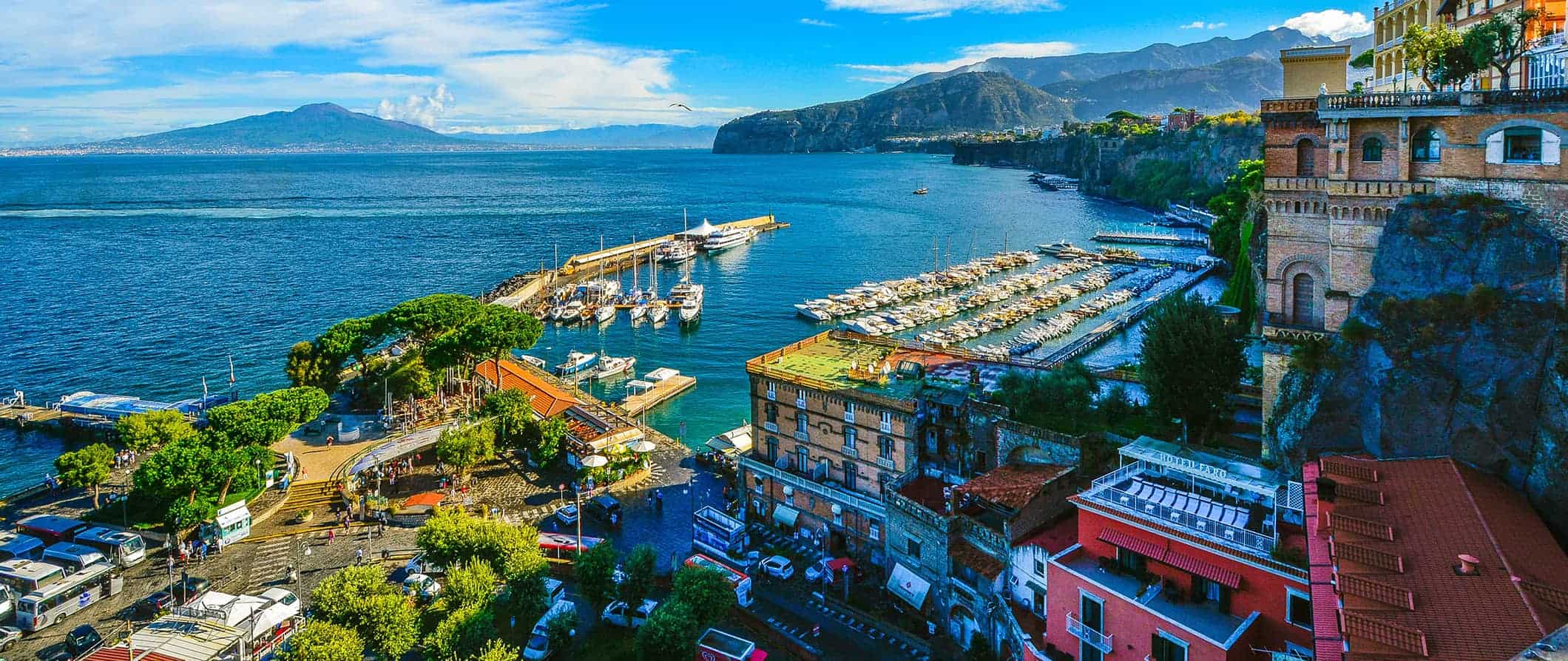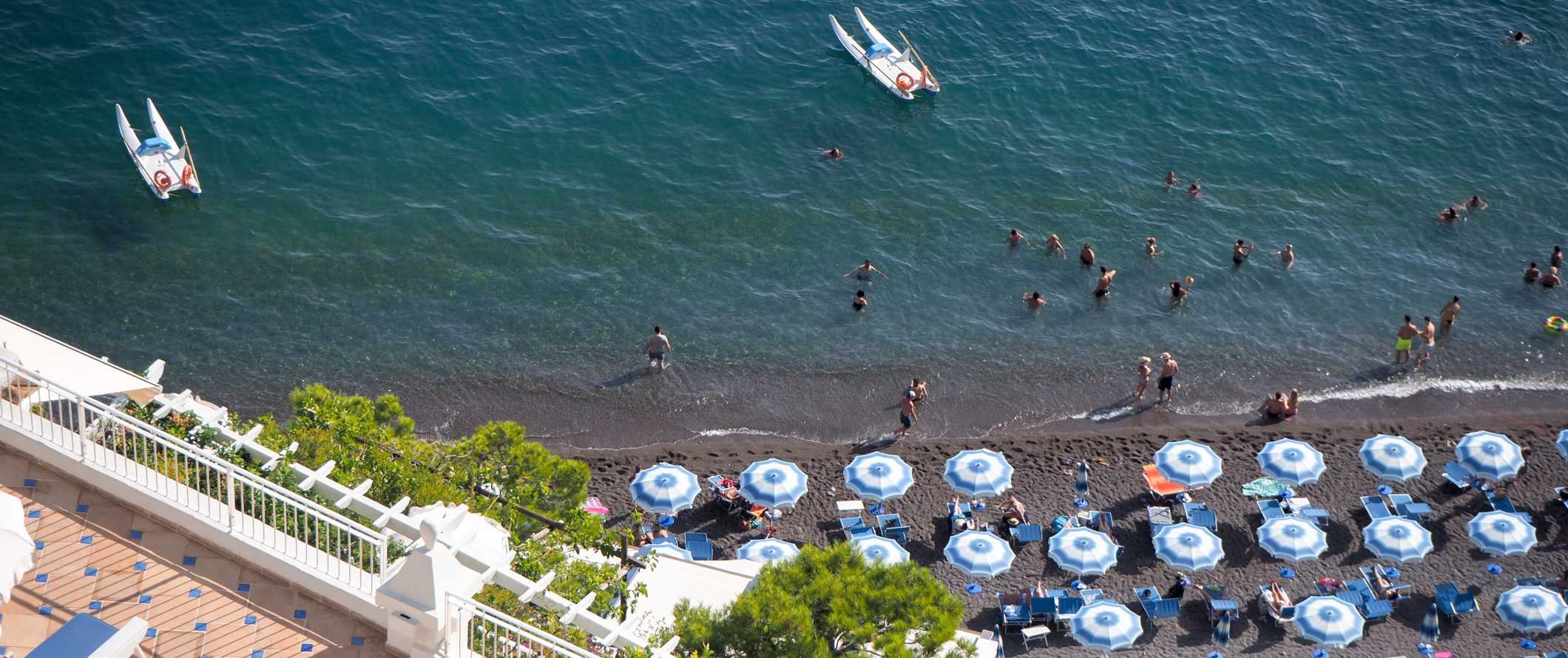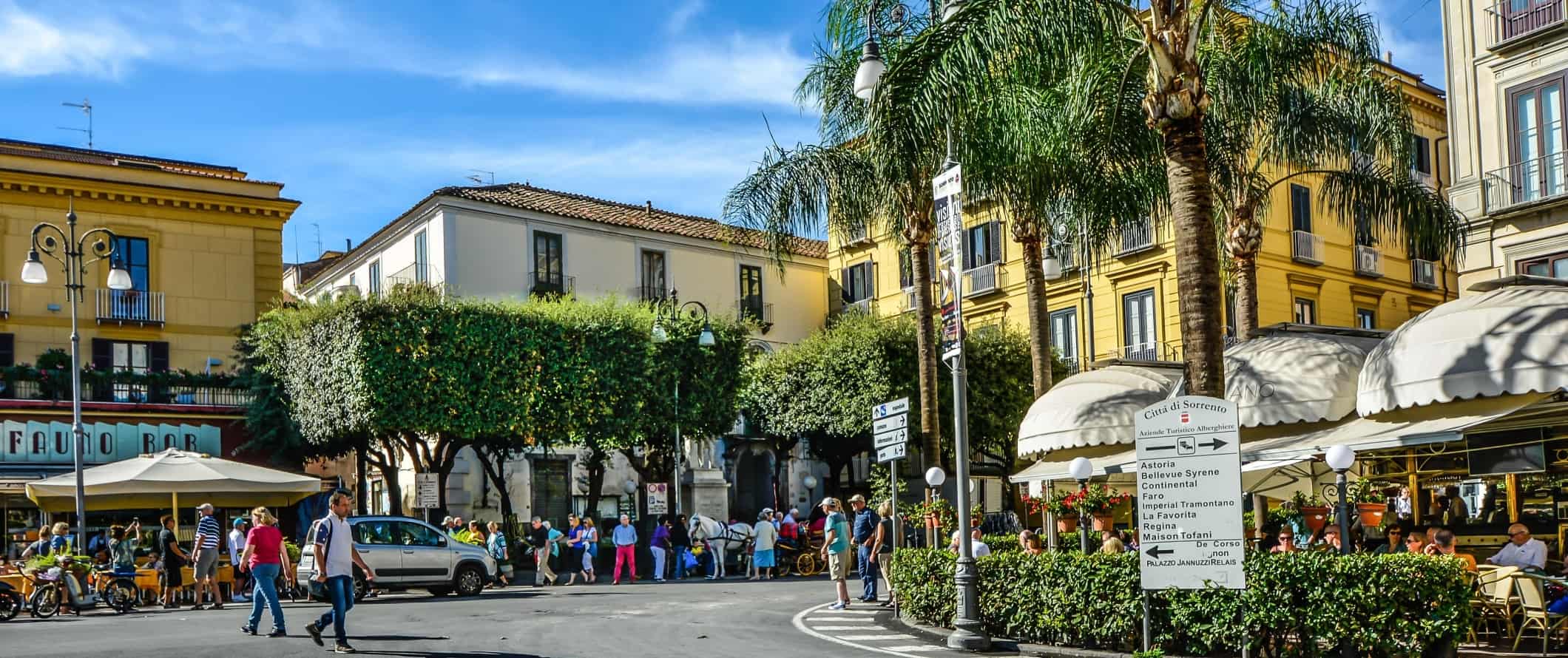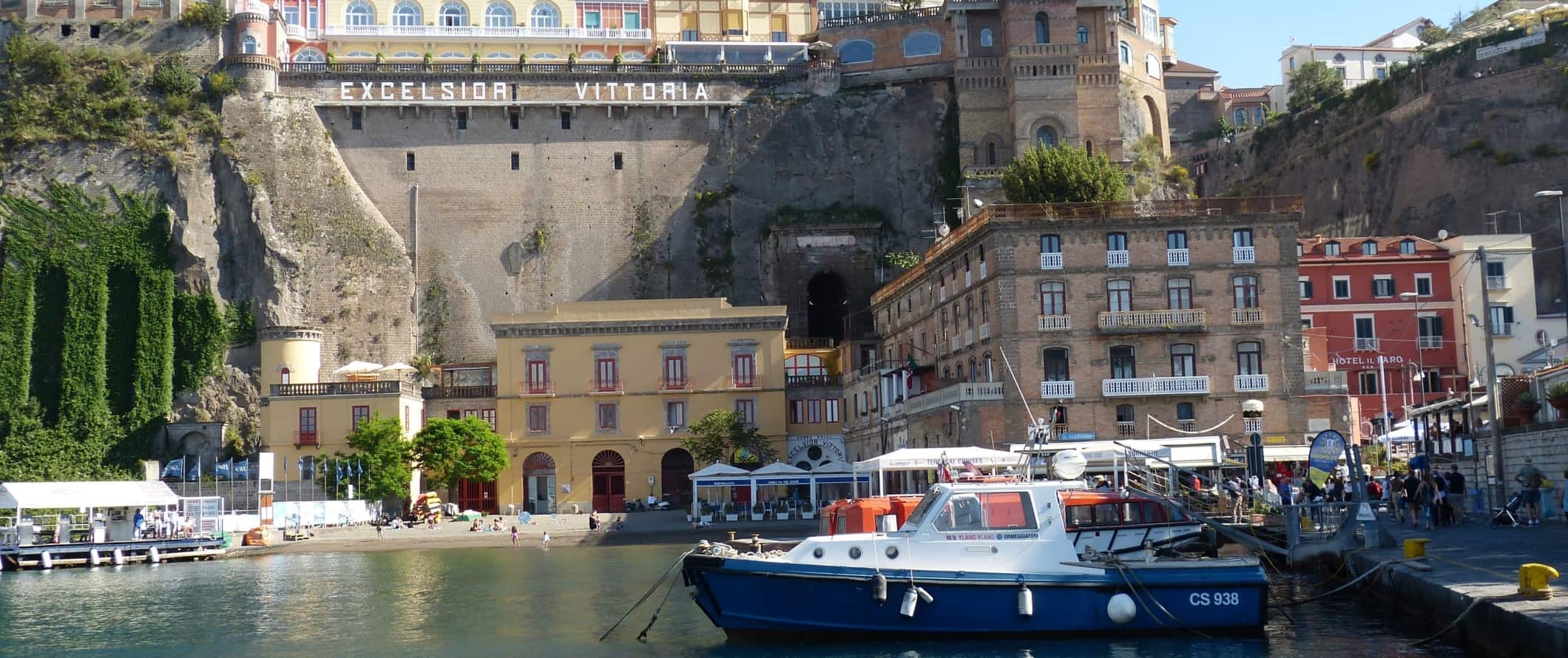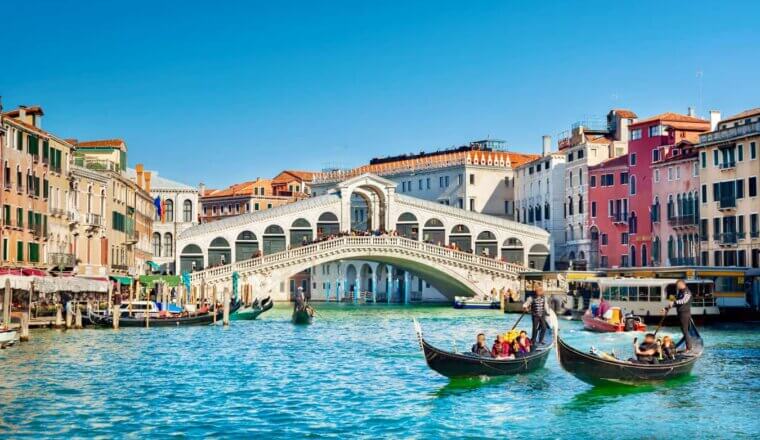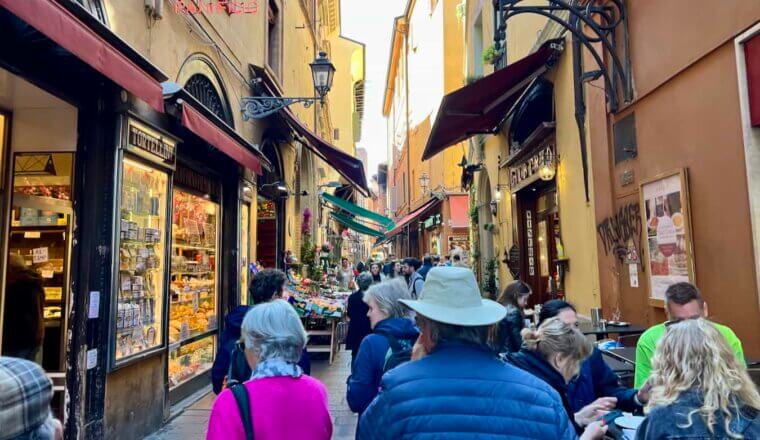Sorrento is a small city in southwestern Italy, surrounded by a dreamy landscape of rolling hills, deep valleys, and the Lattari Mountains.
In the town itself, there isn’t a whole lot to do, but Sorrento makes an ideal starting point for numerous excursions to nearby cities and islands around the famous Amalfi Coast, like Capri and Ischia.
And while Sorrento makes for a nice stop for a couple of days to enjoy the Mediterranean vibes, I think it’s best used as a gateway city to the rest of the region. I especially love driving along the winding coastal roads overlooking the sea. The area is the perfect place for a road trip.
You can use this Sorrento travel guide to help you plan your visit, save money, and make the most out of your time in this beautiful slice of Italia.
Table of Contents
Top 5 Things to See and Do in Sorrento
1. Head to Capri
Just a quick (20-minute) ferry ride from Sorrento, the island of Capri has beautiful beaches, delicious seafood, small villages to explore, and hiking trails. It’s been a resort destination since the Roman Empire and you can still visit the Roman ruins scattered across the small island, including a 1st-century villa. Make sure you also go to the famous Blue Grotto, a small cave on the sea where the light turns the water neon blue. Since a one-way ferry from Sorrento to Capri costs 20 EUR, you might be better off taking a day tour with Get Your Guide. Entrance to the Blue Grotto is 14 EUR. Keep in mind that it can get quite crowded in the high season.
2. Visit Castello Aragonese
This castle is located on a tiny rocky islet connected to the larger island of Ischia by a 15th-century stone causeway. The castle, which takes up nearly the entire rocky islet, dates to the 5th century BCE and at various points in time has served as a defensive stronghold, a noble’s court, and even a convent. Admission to the site costs 12 EUR. A one-way ferry from Sorrento to Ischia is 23 EUR and takes around 1 hour (you can check routes and prices via FerryHopper).
3. Tour the Convent di San Francesco
Originally founded as a monastery in the 7th century, three buildings form Sorrento’s Convent di San Francesco: the church, the convent, and the famous cloister. The convent preserves important works in wood and its unique 14th-century architecture incorporates styles from pagan temples and ancient settlements. It’s a very popular spot for weddings, and in the summer there’s almost always one going on. There’s also often live music here on summer evenings. It’s free to enter.
4. Hit the beach
The beaches around Sorrento are beautiful. Marina Grande and Marina Piccola are two popular spots, though you’re better off heading to Bagni Regina Giovanna for a more relaxing and local spot that has fewer crowds. This isn’t a traditional sandy beach, but rather a natural swimming hole that’s connected to the sea by a rocky archway. It’s located right next to the ruins of a 1st-century Roman villa, showing that this idyllic spot has been a favorite place of relaxation for centuries.
5. Visit the Museo Correale
This museum in the historic center of Sorrento is located in an 18th-century villa overlooking the Bay of Naples. The collection here is extensive and includes Japanese, Chinese, Neapolitan, and European art dating from the 15th-19th centuries. There are also some antique furnishings, ceramics, and Roman and Greek artifacts. Admission is 8 EUR. Every Tuesday and Saturday evening, the Three Tenors in Sorrento perform famous Italian opera arias and Neapolitan classic songs. Tickets start at 45 EUR and you also have the option to enjoy a wine tasting in the garden beforehand.
Other Things to See and Do in Sorrento
1. Admire the Duomo
The simple Romanesque exterior of this 15th-century cathedral is very misleading. The main doors to the cathedral are from Constantinople and date to the 11th century, and while the outside looks plain, the interior is lined with beautiful original furnishings, including wooden choir stalls and the original marble bishop’s throne. There are several stunning frescoes too. Admission is free.
2. Head to Sorrento Cape
Here you will find sandy beaches and the archaeological site of the villa of Pollio Felice. Back in the 1st century BCE, elite Romans started building vacation villas along the coast. Pollio Felice was one such person. He was a member of the Pozzuoli noble family, and while there are a few remains left behind from his villa, there’s also a reconstructed model of his villa in the Georges Vallet Archeological Museum. The cape and villa are just 3.5 kilometers (2.1 miles) outside Sorrento, next to the secluded swimming hole mentioned above, Bagni Regina Giovanna. Admission is free.
4. Explore Marina di Puolo
This picturesque seaside village used to be a popular hideaway for Pollio Felice (mentioned above), and modern-day Marina di Puolo still has just a couple of hundred inhabitants. Most people come here to escape the crowds and lounge around on the beach, which is one of the few sandy beaches in the area. Here you’ll also find Punta Campanella, a protected coastal nature reserve where you can do some short day hikes. Legend has it that the cliffs here are the ones from the Sirens sung their song to Ulysses in Homer’s epic poem, The Odyssey. Both the village and the nature reserve make nice side trips from Sorrento.
5. Explore Ischia
Ischia is just like the island of Capri — but without all the tourists. It’s cheaper, and though it lacks the Blue Grotto, I think it’s a better island to visit because it sees far fewer crowds. Inhabited since the Bronze Age, here you’ll find secluded beaches, thermal spas, and Castello Aragonese (which dates to 474 BCE). The mountainous island is quite small, measuring 10 kilometers (6 miles) by 7 kilometers (4 miles), so it’s perfect for a day trip. The ferry from Sorrento costs around 20 EUR (you can check routes and prices via FerryHopper).
6. Learn about the art of marquetry
Sorrento is known for its marquetry handicrafts, a term that refers to inlaid objects (like pearls or other decorative materials) on wood. You can visit the Museo Bottega della Tarsia Lignea to learn about this art form, which was particularly popular in the 19th century. Located in a bright red, 18th-century palace, the museum also hosts paintings and prints from the 19th century that showcases what the region looked like at the time. Admission is 8 EUR.
7. Visit the Archaeological Museum
The Territorial Archaeological Museum George Vallet is located in a Neoclassical building. The collection consists of archaeological artifacts and art unearthed along the Sorrento Peninsula. They have temporary exhibits often too and there are some pieces from ancient Greece as well. Entry is free, though it’s temporarily closed due to COVID.
8. Eat your heart out
Italy is a country for foodies, and Sorrento is no exception. To take in all that Sorrento has to offer, take a food tour. Sorrento Food Tours offers tasty tours around the city that introduce you to the best the city has to offer (they have a food and wine tour too in case you get thirsty!). Tours cost around 75 EUR per person.
9. Visit Pompeii and Herculaneum
Although Naples is usually the hopping off point for exploring Pompeii and Herculaneum, it’s easy to do so from Sorrento as well. Both Roman towns were buried in layers of ash from the eruption of Mount Vesuvius in in 79 CE, creating fascinating snapshots in time. Exploring the incredibly well-preserved ruins of these ancient towns is a must. Entry to Pompeii is 16 EUR and Herculaneum is 11 EUR.
10. Try limoncello
While it was only recently invented (at the turn of the 20th century), limoncello is one of Italy’s most famous liqueurs. Made from lemon zest soaked in alcohol and mixed with simple syrup, limoncello is normally served as an aperitif (before dinner) or digestif (after dinner). It’s mainly produced in Southern Italy, in and around Sorrento, with lemons grown directly in the region. Learn more about this popular drink by touring a lemon grove and doing a tasting. Tours are 20-25 EUR.
For more information on other cities in Italy, check out these guides:
Sorrento Travel Costs
Hostel prices – Hostels are limited here. A bed in a dorm with 6-8 beds costs 33-40 EUR per night in peak season and 17-25 EUR per night in the off-season. Private double rooms start at 100 EUR per night in peak season and 67 EUR in the off-season. Free Wi-Fi is standard and some hostels include free breakfast.
There are a handful of campgrounds nearby for those traveling with a tent. A basic plot for two costs 28-35 EUR per night for a pitch without electricity. Many of these campgrounds also offer glamping-style tents and cabins from 60-70 EUR per night.
Budget hotel prices – There aren’t a lot of options for a two-star budget hotel in Sorrento. For a three-star budget hotel, prices range from 125-175 EUR per night in peak season, and 60-90 EUR in the off-peak season. Expect basic amenities like free Wi-Fi, TV, and AC. Many of the hotel options are bed and breakfasts that also include free breakfast.
On Airbnb, you can find private rooms for 60-90 EUR per night. You can also rent entire homes for 100-200 EUR per night. Expect to pay double those prices if you don’t book early.
Average cost of food – Italian cuisine is beloved around the world, though every region in Italy offers its own distinct flavor. Tomatoes, pasta, olives, and olive oil form the backbone of most meals, with meat and fish and various cheeses rounding out the menu. In Sorrento, pizza is a must, owing to its invention in nearby Naples (locals actually argue they have better pizza than Naples). Seafood, too, is a huge staple here. Local favorites are gnocchi alla Sorrentina (potato gnocchi), spaghetti e Vongole (spaghetti with clams), octopus casserole, sauteed shrimp, and of course gelato and limoncello.
A casual meal of pizza or pasta shouldn’t cost much more than 12 EUR. Seafood dishes start at 15-17 EUR. If you want to splash out, a three-course meal at a mid-range restaurant serving traditional cuisine costs around 30 EUR.
For street eats, sandwiches and pizza by the slice are usually just 2-7 EUR. Fast food (think burger and fries) costs around 7 EUR.
Beer is around 4-5 EUR while a latte/cappuccino costs around 1.25 EUR. A glass of wine is around 3-4 EUR, though you’ll more often find it offered by the bottle, with a bottle of house wine at a restaurant costing 12-15 EUR. Bottled water is less than 1 EUR.
If you’re staying somewhere with a kitchen, a week’s worth of groceries costs 45-60 EUR. This gets you basic staples like pasta, seasonal produce, and some meat or seafood.
Backpacking Sorrento Suggested Budgets
On a backpacker budget of 55 EUR per day, you can stay in a hostel dorm, cook all your meals, limit your drinking, take public transportation to get around, and stick to mostly free activities like the beaches and visiting the cathedral. If you plan on drinking, add 5-10 EUR to your daily budget.
On a mid-range budget of 155 EUR per day, you can stay in a private Airbnb, cook most of your meals, enjoy a couple of drinks, take the occasional taxi to get around, and do more paid activities like visiting museums and day-tripping to the islands.
On a “luxury” budget of 255 EUR or more per day, you can stay in a hotel, eat out for all your meals, drink more, rent a car, and do whatever tours and activities you want. This is just the ground floor for luxury though. The sky is the limit!
Sorrento Travel Guide: Money-Saving Tips
Sorrento is a popular destination that caters to more upscale travelers. During the summer, it gets very crowded and pricey so you need to watch your budget. Here are some ways to save money when you visit Sorrento:
- Get off the beaten track – Consider visiting Ischia instead of Capri to save some money and beat the crowds, or stay in one of the small neighboring villages at a bed and breakfast instead of in the center of Sorrento.
- Eat pizza and paninis – It may not always be the healthiest option, but you will find pizzas and paninis at most restaurants for a much more affordable rate than the main dishes. Most pizzas cost under 10 EUR.
- Drink the tap water – When at a restaurant, ask for tap water or you will automatically get expensive bottled water included on your bill instead.
- Buy your own alcohol – You can buy a great bottle of wine for 6-10 EUR at the grocery store. It’s much cheaper than going to a bar.
- Stay with a local – Accommodation here can be expensive so use Couchsurfing to find a local who can host you for free. It’s the best way to save money while connecting with someone who can share their insider tips and advice.
- Bring a water bottle – The tap water here is safe to drink so bring a reusable water bottle to save money and reduce your plastic use. LifeStraw is my go-to brand as their bottles have built-in filters to ensure your water is always clean and safe.
Where to Stay in Sorrento
There are only a few hostels in Sorrento. My recommended places to stay when you visit the city are:
How to Get Around Sorrento
Public transportation – Sorrento’s city center is very small and walkable (only 17,000 people live here), but if you want to get up into the hillside or explore any neighboring areas you have to take public transportation.
Buses around the city cost 1.20 EUR and tickets must be purchased at kiosk shops or the train station (you can’t purchase tickets onboard). Buses run between Sorrento and Meto, Sant’Agnello, Piano, and Massa Lubrense.
If you want to get to the other major towns on the Amalfi Coast (like Salerno and Positano), you can take the SITA buses. These buses cost 1.30-6 EUR, depending on the distance.
Train – The Circumvesuviana railway connects the towns along the Amalfi Coast, but it’s not connected with the national rail, so you can’t purchase tickets on Trenitalia. You have to purchase tickets at the station, and most take cash only. Tickets from Naples to Sorrento cost about 4.50 EUR.
Ferry – If you want to visit Capri, there are frequent ferry services from Sorrento. Tickets cost between 15-20 EUR. A ferry from Sorrento to Ischia costs between 20-22 EUR and takes about an hour.
Taxi– Taxis are costly in Sorrento. If you must take one, the starting fare is around 4 EUR and they go up by around 1.40 EUR per mile. Skip them if you can! Uber is not available in Sorrento.
Bike rental – If you don’t want to walk or bus, you can rent a bike here for as little as 5 EUR per day.
Car rental – Cars can be rented for 25-35 EUR per day for a multi-day rental. While you won’t need one to get around Sorrento, they can come in handy if you want to travel along the coast or do some day trips. For the best rental car deals, use Discover Cars
When to Go to Sorrento
Summer in Sorrento is the best time to visit but it’s also peak season. The beaches are busy, the waters are warm, and the sun is endless! Peak season is from June to August, with July and August being the busiest months. Temperatures hover around 31°C (88°F) so you can enjoy plenty of beach time. Expect accommodation to fill up and prices to rise.
Even spring and fall are busy here too, with crowds lingering around Sorrento until mid-October. The weather is still warm, and some people swim until the end of September (or even later). In October, the average daily temperature is 23°C (73°F). Spring tends to be drier than fall, however.
The average temperature in the winter is 11°C (53°F) daily. It’s quiet around here this time of year; summer is definitely more exciting so I’d likely skip a winter visit.
How to Stay Safe in Sorrento
Sorrento is very safe to visit as violent crimes here are incredibly rare. As in other destinations in Italy, scams and pickpocketing are common so keep your valuables secure and out of sight when on the bus or when in crowded tourist areas.
Don’t leave any valuables on the beach when swimming either as they might get snatched.
Solo female travelers should generally feel safe here, however, the standard precautions apply (never leave your drink unattended at the bar, never walk home alone intoxicated, etc.).
If you’re worried about getting scammed, you can read about common travel scams to avoid here.
If you experience an emergency, dial 113 for assistance.
Always trust your gut instinct. Make copies of your personal documents, including your passport and ID. Forward your itinerary along to loved ones so they’ll know where you are.
The most important piece of advice I can offer is to purchase good travel insurance. Travel insurance will protect you against illness, injury, theft, and cancellations. It’s comprehensive protection in case anything goes wrong. I never go on a trip without it as I’ve had to use it many times in the past. You can use the widget below to find the policy right for you:
Sorrento Travel Guide: The Best Booking Resources
These are my favorite companies to use when I travel. They consistently have the best deals, offer world-class customer service and great value, and overall, are better than their competitors. They are the companies I use the most and are always the starting point in my search for travel deals.
- Skyscanner – Skyscanner is my favorite flight search engine. They search small websites and budget airlines that larger search sites tend to miss. They are hands down the number one place to start.
- Hostelworld – This is the best hostel accommodation site out there with the largest inventory, best search interface, and widest availability.
- Booking.com – The best all around booking site that constantly provides the cheapest and lowest rates. They have the widest selection of budget accommodation. In all my tests, they’ve always had the cheapest rates out of all the booking websites.
- HostelPass – This new card gives you up to 20% off hostels throughout Europe. It’s a great way to save money. They’re constantly adding new hostels too. I’ve always wanted something like this and glad it finallt exists.
- Get Your Guide – Get Your Guide is a huge online marketplace for tours and excursions. They have tons of tour options available in cities all around the world, including everything from cooking classes, walking tours, street art lessons, and more!
- The Man in Seat 61 – This website is the ultimate guide to train travel anywhere in the world. They have the most comprehensive information on routes, times, prices, and train conditions. If you are planning a long train journey or some epic train trip, consult this site.
- Rome2Rio – This website allows you to see how to get from point A to point B the best and cheapest way possible. It will give you all the bus, train, plane, or boat routes that can get you there as well as how much they cost.
- FlixBus – Flixbus has routes between 20 European countries with prices starting as low 5 EUR! Their buses include WiFi, electrical outlets, a free checked bag.
- SafetyWing – Safety Wing offers convenient and affordable plans tailored to digital nomads and long-term travelers. They have cheap monthly plans, great customer service, and an easy-to-use claims process that makes it perfect for those on the road.
- LifeStraw – My go-to company for reusable water bottles with built-in filters so you can ensure your drinking water is always clean and safe.
- Unbound Merino – They make lightweight, durable, easy-to-clean travel clothing.
- Top Travel Credit Cards – Points are the best way to cut down travel expenses. Here’s my favorite point earning credit cards so you can get free travel!
Sorrento Travel Guide: Related Articles
Want more info? Check out all the articles I’ve written on backpacking/traveling Italy and continue planning your trip:
